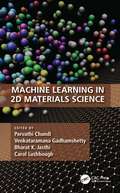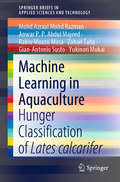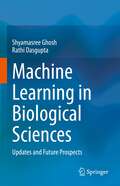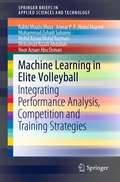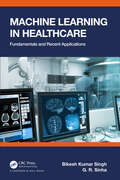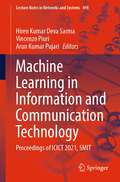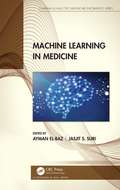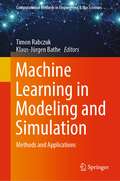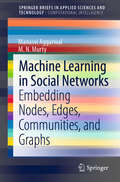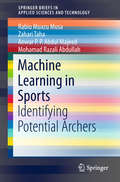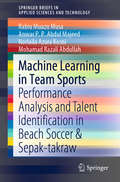- Table View
- List View
Machine Learning in 2D Materials Science
by Parvathi ChundiData science and machine learning (ML) methods are increasingly being used to transform the way research is being conducted in materials science to enable new discoveries and design new materials. For any materials science researcher or student, it may be daunting to figure out if ML techniques are useful for them or, if so, which ones are applicable in their individual contexts, and how to study the effectiveness of these methods systematically. KEY FEATURES • Provides broad coverage of data science and ML fundamentals to materials science researchers so that they can confidently leverage these techniques in their research projects. • Offers introductory material in topics such as ML, data integration, and 2D materials. • Provides in-depth coverage of current ML methods for validating 2D materials using both experimental and simulation data, researching and discovering new 2D materials, and enhancing ML methods with physical properties of materials. • Discusses customized ML methods for 2D materials data and applications and high-throughput data acquisition. • Describes several case studies illustrating how ML approaches are currently leading innovations in the discovery, development, manufacturing, and deployment of 2D materials needed for strengthening industrial products. • Gives future trends in ML for 2D materials, explainable AI, and dealing with extremely large and small, diverse datasets. Aimed at materials science researchers, this book allows readers to quickly, yet thoroughly, learn the ML and AI concepts needed to ascertain the applicability of ML methods in their research.
Machine Learning in 2D Materials Science
Data science and machine learning (ML) methods are increasingly being used to transform the way research is being conducted in materials science to enable new discoveries and design new materials. For any materials science researcher or student, it may be daunting to figure out if ML techniques are useful for them or, if so, which ones are applicable in their individual contexts, and how to study the effectiveness of these methods systematically. KEY FEATURES • Provides broad coverage of data science and ML fundamentals to materials science researchers so that they can confidently leverage these techniques in their research projects. • Offers introductory material in topics such as ML, data integration, and 2D materials. • Provides in-depth coverage of current ML methods for validating 2D materials using both experimental and simulation data, researching and discovering new 2D materials, and enhancing ML methods with physical properties of materials. • Discusses customized ML methods for 2D materials data and applications and high-throughput data acquisition. • Describes several case studies illustrating how ML approaches are currently leading innovations in the discovery, development, manufacturing, and deployment of 2D materials needed for strengthening industrial products. • Gives future trends in ML for 2D materials, explainable AI, and dealing with extremely large and small, diverse datasets. Aimed at materials science researchers, this book allows readers to quickly, yet thoroughly, learn the ML and AI concepts needed to ascertain the applicability of ML methods in their research.
Machine Learning in Aquaculture: Hunger Classification of Lates calcarifer (SpringerBriefs in Applied Sciences and Technology)
by Zahari Taha Gian-Antonio Susto Yukinori Mukai Mohd Azraai Mohd Razman Anwar P. P. Abdul Majeed Rabiu Muazu MusaThis book highlights the fundamental association between aquaculture and engineering in classifying fish hunger behaviour by means of machine learning techniques. Understanding the underlying factors that affect fish growth is essential, since they have implications for higher productivity in fish farms. Computer vision and machine learning techniques make it possible to quantify the subjective perception of hunger behaviour and so allow food to be provided as necessary. The book analyses the conceptual framework of motion tracking, feeding schedule and prediction classifiers in order to classify the hunger state, and proposes a system comprising an automated feeder system, image-processing module, as well as machine learning classifiers. Furthermore, the system substitutes conventional, complex modelling techniques with a robust, artificial intelligence approach. The findings presented are of interest to researchers, fish farmers, and aquaculture technologist wanting to gain insights into the productivity of fish and fish behaviour.
Machine Learning in Biological Sciences: Updates and Future Prospects
by Shyamasree Ghosh Rathi DasguptaThis book gives an overview of applications of Machine Learning (ML) in diverse fields of biological sciences, including healthcare, animal sciences, agriculture, and plant sciences. Machine learning has major applications in process modelling, computer vision, signal processing, speech recognition, and language understanding and processing and life, and health sciences. It is increasingly used in understanding DNA patterns and in precision medicine. This book is divided into eight major sections, each containing chapters that describe the application of ML in a certain field. The book begins by giving an introduction to ML and the various ML methods. It then covers interesting and timely aspects such as applications in genetics, cell biology, the study of plant-pathogen interactions, and animal behavior. The book discusses computational methods for toxicity prediction of environmental chemicals and drugs, which forms a major domain of research in the field of biology. It is of relevance to post-graduate students and researchers interested in exploring the interdisciplinary areas of use of machine learning and deep learning in life sciences.
Machine Learning in Chemical Safety and Health: Fundamentals with Applications
by Qingsheng WangIntroduces Machine Learning Techniques and Tools and Provides Guidance on How to Implement Machine Learning Into Chemical Safety and Health-related Model Development There is a growing interest in the application of machine learning algorithms in chemical safety and health-related model development, with applications in areas including property and toxicity prediction, consequence prediction, and fault detection. This book is the first to review the current status of machine learning implementation in chemical safety and health research and to provide guidance for implementing machine learning techniques and algorithms into chemical safety and health research. Written by an international team of authors and edited by renowned experts in the areas of process safety and occupational and environmental health, sample topics covered within the work include: An introduction to the fundamentals of machine learning, including regression, classification and cross-validation, and an overview of software and toolsDetailed reviews of various applications in the areas of chemical safety and health, including flammability prediction, consequence prediction, asset integrity management, predictive nanotoxicity and environmental exposure assessment, and morePerspective on the possible future development of this field Machine Learning in Chemical Safety and Health serves as an essential guide on both the fundamentals and applications of machine learning for industry professionals and researchers in the fields of process safety, chemical safety, occupational and environmental health, and industrial hygiene.
Machine Learning in Chemical Safety and Health: Fundamentals with Applications
by Qingsheng Wang Changjie CaiIntroduces Machine Learning Techniques and Tools and Provides Guidance on How to Implement Machine Learning Into Chemical Safety and Health-related Model Development There is a growing interest in the application of machine learning algorithms in chemical safety and health-related model development, with applications in areas including property and toxicity prediction, consequence prediction, and fault detection. This book is the first to review the current status of machine learning implementation in chemical safety and health research and to provide guidance for implementing machine learning techniques and algorithms into chemical safety and health research. Written by an international team of authors and edited by renowned experts in the areas of process safety and occupational and environmental health, sample topics covered within the work include: An introduction to the fundamentals of machine learning, including regression, classification and cross-validation, and an overview of software and toolsDetailed reviews of various applications in the areas of chemical safety and health, including flammability prediction, consequence prediction, asset integrity management, predictive nanotoxicity and environmental exposure assessment, and morePerspective on the possible future development of this field Machine Learning in Chemical Safety and Health serves as an essential guide on both the fundamentals and applications of machine learning for industry professionals and researchers in the fields of process safety, chemical safety, occupational and environmental health, and industrial hygiene.
Machine Learning in Cognitive IoT
by Neeraj Kumar Aaisha MakkarThis book covers the different technologies of Internet, and machine learning capabilities involved in Cognitive Internet of Things (CIoT). Machine learning is explored by covering all the technical issues and various models used for data analytics during decision making at different steps. It initiates with IoT basics, its history, architecture and applications followed by capabilities of CIoT in real world and description of machine learning (ML) in data mining. Further, it explains various ML techniques and paradigms with different phases of data pre-processing and feature engineering. Each chapter includes sample questions to help understand concepts of ML used in different applications. Explains integration of Machine Learning in IoT for building an efficient decision support system Covers IoT, CIoT, machine learning paradigms and models Includes implementation of machine learning models in R Help the analysts and developers to work efficiently with emerging technologies such as data analytics, data processing, Big Data, Robotics Includes programming codes in Python/Matlab/R alongwith practical examples, questions and multiple choice questions
Machine Learning in Cognitive IoT
by Neeraj Kumar Aaisha MakkarThis book covers the different technologies of Internet, and machine learning capabilities involved in Cognitive Internet of Things (CIoT). Machine learning is explored by covering all the technical issues and various models used for data analytics during decision making at different steps. It initiates with IoT basics, its history, architecture and applications followed by capabilities of CIoT in real world and description of machine learning (ML) in data mining. Further, it explains various ML techniques and paradigms with different phases of data pre-processing and feature engineering. Each chapter includes sample questions to help understand concepts of ML used in different applications. Explains integration of Machine Learning in IoT for building an efficient decision support system Covers IoT, CIoT, machine learning paradigms and models Includes implementation of machine learning models in R Help the analysts and developers to work efficiently with emerging technologies such as data analytics, data processing, Big Data, Robotics Includes programming codes in Python/Matlab/R alongwith practical examples, questions and multiple choice questions
Machine Learning in Document Analysis and Recognition (Studies in Computational Intelligence #90)
by Simone Marinai Hiromichi FujisawaThe objective of Document Analysis and Recognition (DAR) is to recognize the text and graphical components of a document and to extract information. This book is a collection of research papers and state-of-the-art reviews by leading researchers all over the world. It includes pointers to challenges and opportunities for future research directions. The main goal of the book is to identify good practices for the use of learning strategies in DAR.
Machine Learning in Elite Volleyball: Integrating Performance Analysis, Competition and Training Strategies (SpringerBriefs in Applied Sciences and Technology)
by Rabiu Muazu Musa Anwar P. Abdul Majeed Muhammad Zuhaili Suhaimi Mohd Azraai Mohd Razman Mohamad Razali Abdullah Noor Azuan Abu OsmanThis brief highlights the use of various Machine Learning (ML) algorithms to evaluate training and competitional strategies in Volleyball, as well as to identify high-performance players in the sport. Several psychological elements/strategies coupled with human performance parameters are discussed in view to ascertain their impact on performance in elite Volleyball competitions. It presents key performance indicators as well as human performance parameters that can be used in future evaluation of team performance and players. The details outlined in this brief are vital to coaches, club managers, talent identification experts, performance analysts as well as other important stakeholders in the evaluation of performance and to foster improvement in this sport.
Machine Learning in Healthcare: Fundamentals and Recent Applications
by Bikesh Kumar Singh G.R. SinhaArtificial intelligence (AI) and machine learning (ML) techniques play an important role in our daily lives by enhancing predictions and decision-making for the public in several fields such as financial services, real estate business, consumer goods, social media, etc. Despite several studies that have proved the efficacy of AI/ML tools in providing improved healthcare solutions, it has not gained the trust of health-care practitioners and medical scientists. This is due to poor reporting of the technology, variability in medical data, small datasets, and lack of standard guidelines for application of AI. Therefore, the development of new AI/ML tools for various domains of medicine is an ongoing field of research. Machine Learning in Healthcare: Fundamentals and Recent Applications discusses how to build various ML algorithms and how they can be applied to improve healthcare systems. Healthcare applications of AI are innumerable: medical data analysis, early detection and diagnosis of disease, providing objective-based evidence to reduce human errors, curtailing inter- and intra-observer errors, risk identification and interventions for healthcare management, real-time health monitoring, assisting clinicians and patients for selecting appropriate medications, and evaluating drug responses. Extensive demonstrations and discussion on the various principles of machine learning and its application in healthcare is provided, along with solved examples and exercises. This text is ideal for readers interested in machine learning without any background knowledge and looking to implement machine-learning models for healthcare systems.
Machine Learning in Healthcare: Fundamentals and Recent Applications
by Bikesh Kumar Singh G.R. SinhaArtificial intelligence (AI) and machine learning (ML) techniques play an important role in our daily lives by enhancing predictions and decision-making for the public in several fields such as financial services, real estate business, consumer goods, social media, etc. Despite several studies that have proved the efficacy of AI/ML tools in providing improved healthcare solutions, it has not gained the trust of health-care practitioners and medical scientists. This is due to poor reporting of the technology, variability in medical data, small datasets, and lack of standard guidelines for application of AI. Therefore, the development of new AI/ML tools for various domains of medicine is an ongoing field of research. Machine Learning in Healthcare: Fundamentals and Recent Applications discusses how to build various ML algorithms and how they can be applied to improve healthcare systems. Healthcare applications of AI are innumerable: medical data analysis, early detection and diagnosis of disease, providing objective-based evidence to reduce human errors, curtailing inter- and intra-observer errors, risk identification and interventions for healthcare management, real-time health monitoring, assisting clinicians and patients for selecting appropriate medications, and evaluating drug responses. Extensive demonstrations and discussion on the various principles of machine learning and its application in healthcare is provided, along with solved examples and exercises. This text is ideal for readers interested in machine learning without any background knowledge and looking to implement machine-learning models for healthcare systems.
Machine Learning in Healthcare and Security: Advances, Obstacles, and Solutions (Artificial Intelligence in Smart Healthcare Systems)
by Prashant Pranav Archana Patel Sarika JainThis book brings together a blend of different areas of machine learning and recent advances in the area. From the use of ML in healthcare to security, this book encompasses several areas related to ML while keeping a check on traditional ML algorithms. Machine Learning in Healthcare and Security: Advances, Obstacles, and Solutions describes the predictive analysis and forecasting techniques in different emerging and classical areas using the approaches of ML and AI. It discusses the application of ML and AI in medical diagnostic systems and deals with the security prevention aspects of ML and how it can be used to tackle various emerging security issues. This book also focuses on NLP and understanding the techniques, obstacles, and possible solutions. This is a valuable reference resource for researchers and postgraduate students in healthcare systems engineering, computer science, cyber-security, information technology, and applied mathematics.
Machine Learning in Healthcare and Security: Advances, Obstacles, and Solutions (Artificial Intelligence in Smart Healthcare Systems)
This book brings together a blend of different areas of machine learning and recent advances in the area. From the use of ML in healthcare to security, this book encompasses several areas related to ML while keeping a check on traditional ML algorithms. Machine Learning in Healthcare and Security: Advances, Obstacles, and Solutions describes the predictive analysis and forecasting techniques in different emerging and classical areas using the approaches of ML and AI. It discusses the application of ML and AI in medical diagnostic systems and deals with the security prevention aspects of ML and how it can be used to tackle various emerging security issues. This book also focuses on NLP and understanding the techniques, obstacles, and possible solutions. This is a valuable reference resource for researchers and postgraduate students in healthcare systems engineering, computer science, cyber-security, information technology, and applied mathematics.
Machine Learning in Industry (Management and Industrial Engineering)
by Shubhabrata Datta J. Paulo DavimThis book covers different machine learning techniques such as artificial neural network, support vector machine, rough set theory and deep learning. It points out the difference between the techniques and their suitability for specific applications. This book also describes different applications of machine learning techniques for industrial problems. The book includes several case studies, helping researchers in academia and industries aspiring to use machine learning for solving practical industrial problems.
Machine Learning in Information and Communication Technology: Proceedings of ICICT 2021, SMIT (Lecture Notes in Networks and Systems #498)
by Hiren Kumar Deva Sarma Vincenzo Piuri Arun Kumar PujariThis book presents collection of research papers presented at International Conference on Information and Communication Technology (ICICT 2021) organized by Department of Information Technology, Sikkim Manipal Institute of Technology, Sikkim, India, during 23–24 December 2021. The book includes papers in the research area of communication networks, data science, healthcare informatics, bio-medical image processing, security of information including cryptography, machine learning applications, and AI applications.
Machine Learning in Medicine (Chapman & Hall/CRC Healthcare Informatics Series)
by Ayman El-Baz Jasjit S. SuriMachine Learning in Medicine covers the state-of-the-art techniques of machine learning and their applications in the medical field. It presents several computer-aided diagnosis (CAD) systems, which have played an important role in the diagnosis of several diseases in the past decade, e.g., cancer detection, resulting in the development of several successful systems. New developments in machine learning may make it possible in the near future to develop machines that are capable of completely performing tasks that currently cannot be completed without human aid, especially in the medical field. This book covers such machines, including convolutional neural networks (CNNs) with different activation functions for small- to medium-size biomedical datasets, detection of abnormal activities stemming from cognitive decline, thermal dose modelling for thermal ablative cancer treatments, dermatological machine learning clinical decision support systems, artificial intelligence-powered ultrasound for diagnosis, practical challenges with possible solutions for machine learning in medical imaging, epilepsy diagnosis from structural MRI, Alzheimer's disease diagnosis, classification of left ventricular hypertrophy, and intelligent medical language understanding. This book will help to advance scientific research within the broad field of machine learning in the medical field. It focuses on major trends and challenges in this area and presents work aimed at identifying new techniques and their use in biomedical analysis, including extensive references at the end of each chapter.
Machine Learning in Medicine (Chapman & Hall/CRC Healthcare Informatics Series)
by Ayman El-Baz Jasjit S. SuriMachine Learning in Medicine covers the state-of-the-art techniques of machine learning and their applications in the medical field. It presents several computer-aided diagnosis (CAD) systems, which have played an important role in the diagnosis of several diseases in the past decade, e.g., cancer detection, resulting in the development of several successful systems. New developments in machine learning may make it possible in the near future to develop machines that are capable of completely performing tasks that currently cannot be completed without human aid, especially in the medical field. This book covers such machines, including convolutional neural networks (CNNs) with different activation functions for small- to medium-size biomedical datasets, detection of abnormal activities stemming from cognitive decline, thermal dose modelling for thermal ablative cancer treatments, dermatological machine learning clinical decision support systems, artificial intelligence-powered ultrasound for diagnosis, practical challenges with possible solutions for machine learning in medical imaging, epilepsy diagnosis from structural MRI, Alzheimer's disease diagnosis, classification of left ventricular hypertrophy, and intelligent medical language understanding. This book will help to advance scientific research within the broad field of machine learning in the medical field. It focuses on major trends and challenges in this area and presents work aimed at identifying new techniques and their use in biomedical analysis, including extensive references at the end of each chapter.
Machine Learning In Microservices: Productionizing Microservices Architecture For Machine Learning Solutions
by Omar Ahmed Mohamed AbouahmedProductionizing microservices architecture for machine learning solutions
Machine Learning in Modeling and Simulation: Methods and Applications (Computational Methods in Engineering & the Sciences)
by Timon Rabczuk Klaus-Jürgen BatheMachine learning (ML) approaches have been extensively and successfully employed in various areas, like in economics, medical predictions, face recognition, credit card fraud detection, and spam filtering. There is clearly also the potential that ML techniques developed in Engineering and the Sciences will drastically increase the possibilities of analysis and accelerate the design to analysis time. With the use of ML techniques, coupled to conventional methods like finite element and digital twin technologies, new avenues of modeling and simulation can be opened but the potential of these ML techniques needs to still be fully harvested, with the methods developed and enhanced. The objective of this book is to provide an overview of ML in Engineering and the Sciences presenting fundamental theoretical ingredients with a focus on the next generation of computer modeling in Engineering and the Sciences in which the exciting aspects of machine learning are incorporated. The book is of value to any researcher and practitioner interested in research or applications of ML in the areas of scientific modeling and computer aided engineering.
Machine Learning in Signal Processing: Applications, Challenges, and the Road Ahead
by Sudeep TanwarMachine Learning in Signal Processing: Applications, Challenges, and the Road Ahead offers a comprehensive approach toward research orientation for familiarizing signal processing (SP) concepts to machine learning (ML). ML, as the driving force of the wave of artificial intelligence (AI), provides powerful solutions to many real-world technical and scientific challenges. This book will present the most recent and exciting advances in signal processing for ML. The focus is on understanding the contributions of signal processing and ML, and its aim to solve some of the biggest challenges in AI and ML. FEATURES Focuses on addressing the missing connection between signal processing and ML Provides a one-stop guide reference for readers Oriented toward material and flow with regards to general introduction and technical aspects Comprehensively elaborates on the material with examples and diagrams This book is a complete resource designed exclusively for advanced undergraduate students, post-graduate students, research scholars, faculties, and academicians of computer science and engineering, computer science and applications, and electronics and telecommunication engineering.
Machine Learning in Signal Processing: Applications, Challenges, and the Road Ahead
by Sudeep Tanwar Anand Nayyar Rudra RameshwarMachine Learning in Signal Processing: Applications, Challenges, and the Road Ahead offers a comprehensive approach toward research orientation for familiarizing signal processing (SP) concepts to machine learning (ML). ML, as the driving force of the wave of artificial intelligence (AI), provides powerful solutions to many real-world technical and scientific challenges. This book will present the most recent and exciting advances in signal processing for ML. The focus is on understanding the contributions of signal processing and ML, and its aim to solve some of the biggest challenges in AI and ML. FEATURES Focuses on addressing the missing connection between signal processing and ML Provides a one-stop guide reference for readers Oriented toward material and flow with regards to general introduction and technical aspects Comprehensively elaborates on the material with examples and diagrams This book is a complete resource designed exclusively for advanced undergraduate students, post-graduate students, research scholars, faculties, and academicians of computer science and engineering, computer science and applications, and electronics and telecommunication engineering.
Machine Learning in Social Networks: Embedding Nodes, Edges, Communities, and Graphs (SpringerBriefs in Applied Sciences and Technology)
by Manasvi Aggarwal M.N. MurtyThis book deals with network representation learning. It deals with embedding nodes, edges, subgraphs and graphs. There is a growing interest in understanding complex systems in different domains including health, education, agriculture and transportation. Such complex systems are analyzed by modeling, using networks that are aptly called complex networks. Networks are becoming ubiquitous as they can represent many real-world relational data, for instance, information networks, molecular structures, telecommunication networks and protein–protein interaction networks. Analysis of these networks provides advantages in many fields such as recommendation (recommending friends in a social network), biological field (deducing connections between proteins for treating new diseases) and community detection (grouping users of a social network according to their interests) by leveraging the latent information of networks. An active and important area of current interest is to come out with algorithms that learn features by embedding nodes or (sub)graphs into a vector space. These tasks come under the broad umbrella of representation learning. A representation learning model learns a mapping function that transforms the graphs' structure information to a low-/high-dimension vector space maintaining all the relevant properties.
Machine Learning in Sports: Identifying Potential Archers (SpringerBriefs in Applied Sciences and Technology)
by Rabiu Muazu Musa Zahari Taha Mohamad Razali Abdullah Anwar P.P.Abdul MajeedThis brief highlights the association of different performance variables that influences archery performance and the employment of different machine learning algorithms in the identification of potential archers. The sport of archery is often associated with a myriad of performance indicators namely bio-physiological, psychological, anthropometric as well as physical fitness. Traditionally, the determination of potential archers is carried out by means of conventional statistical techniques. Nonetheless, such methods often fall short in associating non-linear relationships between the variables. This book explores the notion of machine learning that is capable of mitigating the aforesaid issue. This book is valuable for coaches and managers in identifying potential archers during talent identification programs.
Machine Learning in Team Sports: Performance Analysis and Talent Identification in Beach Soccer & Sepak-takraw (SpringerBriefs in Applied Sciences and Technology)
by Rabiu Muazu Musa Anwar P.P. Abdul Majeed Norlaila Azura Kosni Mohamad Razali AbdullahThis brief highlights the application of performance analysis tools in data acquisition, and various machine learning algorithms for evaluating team performance as well as talent identification in beach soccer and sepak takraw. Numerous performance indicators and human performance parameters are considered based on their relevance to each sport. The findings presented here demonstrate that the key performance indicators as well as human performance parameters can be used in the future evaluation of team performance as well as talent identification in these sports. Accordingly, they offer a valuable resource for coaches, club managers, talent identification experts, performance analysts and other relevant stakeholders involved in performance assessments.
